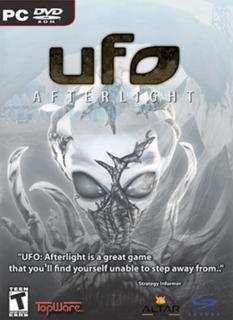I've found that gamespot reviews of X-com clones tend to be quite critical and quite often rushed. So here is my take.
Like its predecessors in the series, UFO: Afterlight is a clone of the X-com formula that has benefited greatly from the previous 2 games in the Altair UFO series. It’s combat engine is much more streamlined and the entire game generally feels quite smooth. Despite the terrible starting tutorial for the game and the lack of any guidance, you should be able to get a grasp over most of the features if you've played any X-com games or its clones before. However the game does indeed lack a proper way of schooling total newbies and might take abit of patience combined with abit of trial & error. This is defiantly a bad call as it’ll put off a lot of people from experiencing this great game.
You start the game with a settlement on mars and an alliance to the reticulans, your former enemies. Your main goal is to establish yourself on mars and figure out a way of turning it into your new home. However your weapons are extremely primitive & as you begin expanding your territories while fighting the Robotic defenses left behind by the martians you trigger some sort of gate device that causes the appearance of a new enemy, beast men. You'll spend the rest of the game trying to get rid of these beast men while defending yourself as they'll become your main foe, however you will be fighting other factions throughout the game as the story progresses.
While previous X-com-like games usually meant researching the best weapons & armour to win. This game puts more emphasis on tactics, strategy & adaptability, which is one of the greatest things about this game. Each alien is vulnerable to one type of weapon or another and it’s your job to figure that out & prepare your different troops for all these different missions & enemies. As you become more powerful, new challenges arise, new enemies appear and with them new research capabilities for better weapons & tactics. If you try to go about it in the usual fashion of getting the highest of everything you'll probably end up like the original GS reviewer feeling that the game is hard. There are 4 types of weaponry you can branch off into and while focusing on one can help you greatly you'll begin to notice the disadvantages of abandoning the other trees as the different factions & enemies react differently to these weapons. Reticulans for example are extremely vulnerable to projectile weapons while beast men are mildly vulnerable to them, however the robotic defenses & even the martians themselves are hardly affected by them. You can also similarly choose between medium & heavy armour, trading off mobility for defense, but more defense isn’t always best in this game. These strategic choices can greatly affect the outcome of your tactical battles.
Weaponry & armour aren’t the only ways of adapting to your enemies, the great RPG style of interaction with your soldiers & characters can help immensely in tackling the rising threats. You can train your soldiers in all sorts of different tactics & skills that can help you greatly in tactical combat. Soldiers can be trained in stealth, heavy weapons & the different anatomies of aliens amongst other things, making them more effective in a certain area. Not all missions require you to go in with guns blazing. Some missions can be easily solved with stealth while others require careful tactics as you only need to achieve a certain objective to win, unlike the usual "kill everything that moves" method. This can spare you the agony of trying to fight a superior enemy with inferior weapons while your scientists try to catch up to the technological gaps.
Your scientists & technicians too have similar skills that help them in research & production. With careful mixing & matching you can create a great team capable of tackling any new threats. Scientists that can quickly reverse engineer anything captured from the aliens & technicians that can quickly manufacture or construct whatever is needed.
The game includes a great variety of maps and would rarely feel repetitive, however you’ll probably run across a few of them again, specially with the AI’s tendency to keep attacking the same province a few times in a row. However the maps themselves change as you begin terraforming mars into your new home. Visible effects of your terraforming slowly start appearing right in front of you on the geoscope and even in the maps. You start to see more green around your stations while plants & more green appear on your tactical maps. These add great variety & color to the somewhat dull martian atmosphere. The more progress you make in terraforming, the more visible the effects. This is another of the best features in this game in my opinion.
However some of its major events including the ending can feel somewhat anticlimactic as it fails to live up to the apocalyptic ending you’d like it to be. Nevertheless this is a great game that should offer hours of great gameplay & fun because of its engaging design & rewarding atmosphere. It’s truly a great sequel to the Altair UFO series and a great clone to the X-com original that comes close to representing what the original game would’ve been like with modern technology while still being original. It seems Altair has learnt much from their previous mistakes with the other 2 games and successfully managed to pull off a great X-com clone and a great series.

